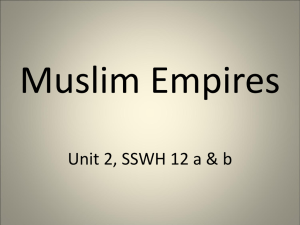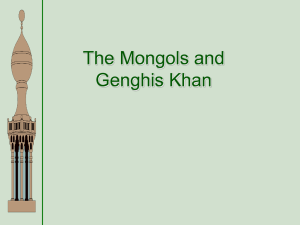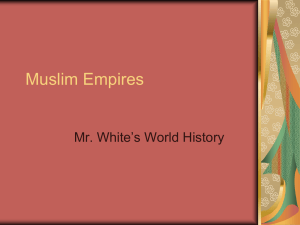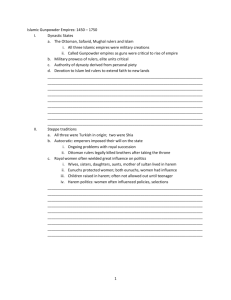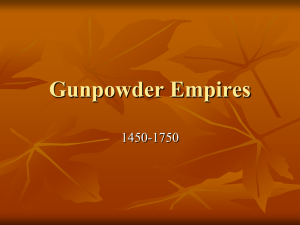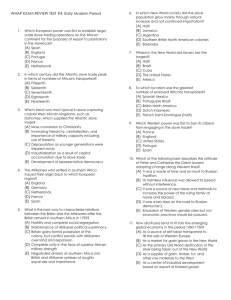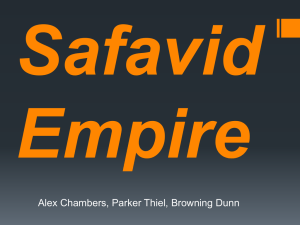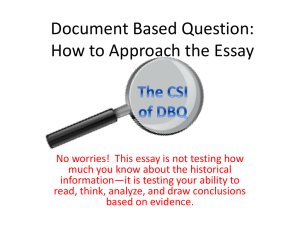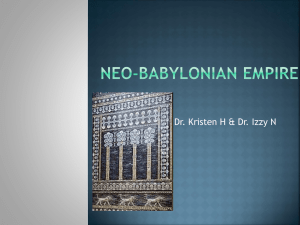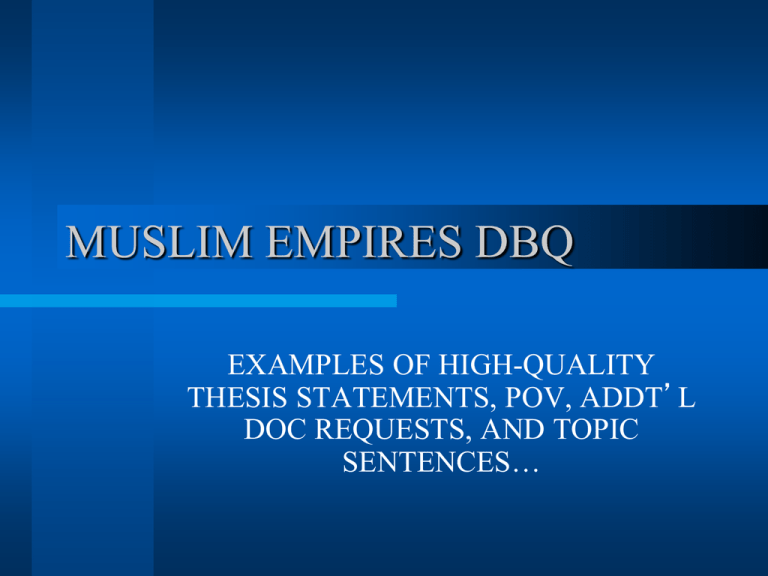
MUSLIM EMPIRES DBQ
EXAMPLES OF HIGH-QUALITY
THESIS STATEMENTS, POV, ADDT’L
DOC REQUESTS, AND TOPIC
SENTENCES…
Comp Theses: Islamic
Gunpowder Empires
From 1450-1750 both the Mughal and Ottoman Empires established
large functioning bureaucracies through the establishment of
religiously tolerant policies over large non-Muslim groups, both will
grow wealthy due to the control over lucrative trade routes, however,
predominantly Hindu Mughal will have advisors of government of
many faiths while the Millet system of religious enclaves
(communities) will be the closest any non-Muslims have in
governmental decision-making
The Ottoman and Safavid Empires 1450-1750 were both Turkic lead
assaults for empire establishment after the vacuum of authority the
Mongols built, both will be dominated by Islamic rule ( Sharia,5
Pillars,Hadith) but the Sunni led Ottoman will be far more tolerant
than the Shiite led Safavid eventually going to war and signifying the
beginning of the end for the Safavid.
Trade & DEMOGRAPHY
Agriculture: the basis of all three empires
–
Major crops: wheat, rice
–
Little impacted by new American
crops
Imports of coffee, tobacco very popular
–
Coffee discovered in Jaffa Province
(Ethiopia)
–
Coffee houses developed, a major
social tradition
Peasants
–
Tended to be overtaxed,
overworked by nobles
–
Many so mistreated that they
abandoned their lands
Demographics
–
Population growth less dramatic than
in China, Europe
•
India: significant growth due to
intense agriculture
•
Less dramatic growth in Safavid
and Ottoman empires
–
All empires were multi-national,
multi-religious
Trade
–
Long-distance trade
important to all three
empires
•
Minorities controlled
trade in all three states in
trade diasporas
•
Trade goods tended to
be traditional arts, crafts;
little manufacturing
•
Ottomans, Safavids
shared parts of east-west
trade routes
–
Safavids offered silk,
carpets, ceramics to
Europeans
–
Mughal empires less
attentive to foreign or
maritime trading
•
Mughals permitted
stations for English,
French, Dutch
•
Europeans gradually
exclude Indian influence
culture
Sponsored arts and public works
– Golden Age of Islamic art, architecture
– Mosques, palaces, schools, hospitals, caravanserais
Istanbul
– Ottoman capital, a bustling city of a million people
– Topkapi palace housed government, sultan's residence
– Suleyman blended Islamic, Byzantine architecture
Isfahan
– Safavid capital
– The "queen of Persian cities“
– The central mosque is a wonder of architecture
Fatehpur Sikri, Mughal capital, created by Akbar
– Combined Islamic style with Indian elements
– Site abandoned because of bad water supply
– Taj Mahal, exquisite example of Mughal architecture
Decline of gunpowder empires
–
–
–
–
–
–
–
Dynastic decline
•
•
•
•
•
•
•
Caused by negligent rulers, factions
Constant competition between factions within government
Former elite military units often became threats
Government corruption
Bribery became way of doing business
Many officials pocketed taxes, overtaxed, etc.
Harem politics
Rulers raised in harems let sex carry them away
Rulers took to drinking, partying too much
Rulers’ mothers, wives jockeyed for position, sons
Tensions increased
•
•
•
•
•
•
•
•
Religious conservatives abandoned tolerance
Ottoman conservatives
Resisted innovations like the telescope, printing press
Resisted western military innovations, industrialization
Discouraged merchants, commercialism
Safavid Empire
Shiite leaders urged shahs to persecute Sunnis
Non-Muslims lost many protections
Mughal India
Aurangzeb's policies provoked deep animosity of Hindus
Rise of Sikhs
Rise of Christians with coming of Europeans
CULTURAL INSULARITY
Cultural conservatism
–
–
–
–
Muslims seldom traveled to the West, confident of their superiority
Science, technology ignored as it is western, threat
Ignorant of European technological developments
Hostile to European, Christian inventions, institutions
Social conservatism
–
–
–
Middle classes failed to develop in Muslim states
Growing gap between ruling elite, peasants/slaves
Growing antagonism between religious elites, ruling elites
Resistance to printing press
–
–
–
At first, Ottomans banned printing in Turkish, Arabic
Ban lifted in 1729; conservatives closed Turkish press in 1742
In India, Mughals showed little interest in printing technology
Xenophobia becomes a cultural trait of Islam
–
–
–
–
Foreign cultural innovations seen as a threat to political stability
Inability to grasp aspects of modern politics, state structures
Muslims cannot believe what is happening to them
More irritating that it is the Christian Europeans who are ruling
REASONS FOR DECLINE
Economy and Military Expansion
Series of long and costly wars with no financial support
– Economy Stagnated by 18th century
• Officials resorted to raising taxes to deal with financial problems
• Official, unofficial corruption lost millions in revenue to state
– Failure to develop trade and industry
Military decline
– Imported European weapons but never made their own
– Arsenals outdated; tactics outdated; systems outdated
– Ottoman Empire
• Even purchased military vessels from abroad
• Europeans developed extremely modern militaries
– India
• Mughals refused to build a navy, let Europeans rule seas
• Led to loss of Mughal provinces
• Local princes, rulers assumed control, defied Mughals
Rise of Banditry, Piracy
– In countryside, many poor peasants took to banditry
– On seas, many ports and merchants too to piracy
– Trade disrupted, made Europeans mad who often retaliated
GOOD THESIS
“Documents 1, 2 and 3 and discuss
the militaristic political climate of the
[Gunpowder] Empires c. 1450-1750,
while documents 4 and 8describe the
tolerant religious climate of the
[Gunpowder] Empires, and
documents 5,6, and 7 display the
religiously intolerant climate of the
empires.”
GOOD THESIS
“While the overall political and
religious climates of the Muslim
Empires in 1450-1750 were tense,
religious tolerance can be seen in the
Mughal and Ottoman Empires.”
GOOD THESIS
“The political and religious climate of
the Muslim Empires in c. 1450-1750
was very tense…The military was
needed to support the government
and to back up political decisions,
while the religious tension was a
result of the close proximity of
various religious groups.”
GOOD THESIS, AND GOOD
TOPIC SENTENCES
“Documents 3 and 4 and 8 portray a tolerant
religious climate throughout the Muslim Empires
c. 1450-1750, while documents 4, 5, 6 and 7show
an intolerant religious climate. Documents 4 and
5 show a diverse religious climate. 5 portray a
tense political climate.”
GOOD POV :”How and why is
this document biased?”
“Document 7 is taken from the perspective of a
missionary who traveled to the Safavid Empire in
order to convert others to Christianity. However,
the missionary failed and upon his return to
Spain, brought along with him the point of view
that all those of the Safavid Empire were rude,
inconsiderate, and [disingenuous] peoples who
merely feigned appreciation of the Spanish
missionaries. This perspective is taken, of
course, only because the missionary was
unsuccessful.”
GOOD POV
“Doc 1 shows how the Muslims
didn’t like the Christian missionaries.
However, Father Simon may have
exaggerated the Muslims’ hostility
because he was making excuses for
his mission’s failure.”
GOOD POV
“Document 7, which is about the Safavid empire,
shows the ruler Shah Abbas’s disrespect for
Christian traditions… However, coming from a
group that was a minority in the Safavid Empire,
Father Simon, the author of Document 3 ,
probably felt that the Muslim shah was more
oppressive than he actually was… Because
Father Simon came to the Safavid Empire to
explore missionary work, it is clear that he viewed
Muslims as wrong and thus would have been
more critical of Islamic rule.”
PROBABLY, OR ALMOST
THERE POV…
“Document 4 also discusses the role of
religion in regard to the political climate of the
Mughal Empire, but is written by one of the
emperors, and thus could be biased when he
describes how his father was so tolerant of
the Hindus.”
– Jahangir may have exaggerated Akbar’s level of
tolerance, because he would have wanted to
positively portray his Muslim family to his Hindu
subjects (especially given the tense religious
climate in the Mughal Empire).
GOOD ADDT’L DOC
“Another document, which would be
helpful in further understanding the
religious climate of the Muslim empires
from 1450-1750, would be an account
written by an indigenous follower of
Judaism (or some religious minority).
This would give us information about how
such minorities adapted to the changes in
religious climate and what their
perspective was on larger religions which
may or may not have oppressed them and
their faith.”
GOOD ADDT’L DOC
“It would be helpful to have a document pertaining to
the perspective of the Hindus. All of the documents
were written by people outside of the empire or a
government official but not from the opinion of a
Hindu. Considering that many documents discuss
being tolerant to them, it would be interesting to hear
from the subjects about that tolerance. A survey
asking the Hindus if they believed they were being
treated fairly would be helpful. That way you could
compare the points of views to decide which is the
more accurate. Considering that the Hindus were the
majority in the Mughal empire, it would be a helpful
document to understand the actual relationship
between the Hindus and the Muslims.
Another one …
An additional document that would be helpful
in better understanding the political and
economic climate of the Muslim empires would
be that of a government official working inside
of the Safavid Empire. Right now, the only
perspective on the Safavid Empire that we have
is that of a disaffected Christian missionary. A
more formal document from someone in the
government could better help us to determine
whether or not the government did in fact
discriminate against religious minorities, thus
creating a hostile religious climate, or if it was
more open minded than the author of document
3 is letting on.

